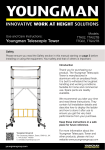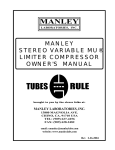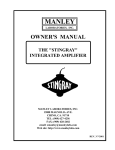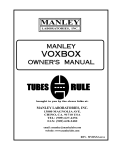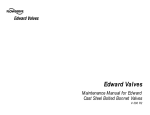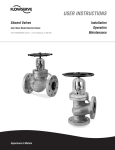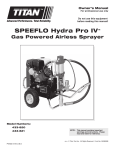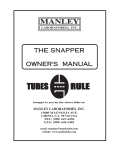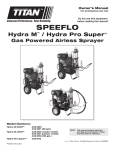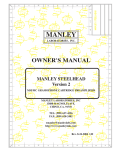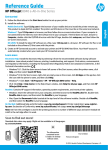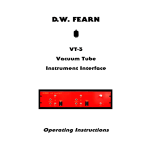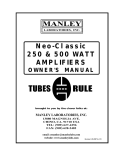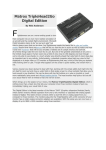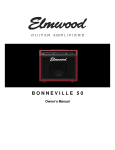Download Manley CONTROL MASTER PREAMPLIFIER Owner`s manual
Transcript
MANLEY LABORATORIES, INC. OWNER'S MANUAL MANLEY TAPE HEAD PREAMPLIFIERS MANLEY LABORATORIES, INC. 13880 MAGNOLIA AVE. CHINO, CA. 91710 TEL: (909) 627-4256 FAX: (909) 628-2482 EMAIL: [email protected] www.manleylabs.com CONTENTS MANLEY TAPE HEAD PREAMPS USER and TECHNICAL MANUAL 3) INTRODUCTION (mostly hype but you can quote us) 4) IMPORTANT (read this even if you hate manuals) 5) WARNINGS (because we have to) 6) TECHNICAL DETAILS (for the person who has to plug it in) 7) ALIGNMENTS (for the person adjusting it daily) 8) PLAYBACK HEADS (yes, you now need special heads) 9 & 10) ALTERNATIVE VERNIER CALIBRATION (cool trick) 10) OTHER LITTLE HINTS(more hints for the cable builder) 11 & 12) EQ ( tech talk) 13) REPLACING TUBES (general tube info) 14) WARRANTY (legal stuff no one ever reads) 15) REGISTRATION CARD (yes, please do send this in to activate your warranty) INTRODUCTION THANK YOU!... for choosing the Manley and congratulations on your purchase of MANLEY LABS TUBE TAPE PREAMP. This product is the result of continual evolution from the era when all tape machines were vacuum tube based to the present with refinements and improvements virtually every year. This preamp was designed to meet the extreme requirements of Mastering Engineers and Audiophile Record Labels. Earlier versions have been used for years by many of the most respected Mastering Studios in America as well as England and Japan. It is very likely some of your favorite records and CDs have passed thru a Manley Tube Tape Preamp and a Manley A to D Converter. The preamp provides a minimal path thru maximum quality components. The amplififcation is entirely "Class A" low noise triode vacuum tube based. The line driver is a high current, low output impedance, high voltage design. The transformer power supply is external to minimize hum radiation. Once the voltages are in the individual chassis they rectified, filtered, regulated and well filtered again at all stages. These design philosophies help recover the delicate sonic details from the tape with all the spatial and spectral infomation intact and with minimal added noise and distortion. The Preamp combined with the Manley Hi-Z heads truly reproduces music from tape with clarity and beauty and with solid impact and excitement. All user adjustments are brought to the front panel. The most used controls feature high resolution "Vernier Control Knobs". These not only provide very fine adjustment but also repeatability required by most Mastering Engineers. The preamp has the common adjustments for "GAIN", HIGH FREQUENCY EQ" and "LOW FREQUENCY EQ" and has unusual adjustments for "VERY HIGH FREQUENCY" and "VERY LOW FREQUENCY" that allow the engineer to obtain a more accurate and flexible reproduction than is normally possible. The preamp also features switches to allow 15/30 IPS selection and polarity reversal. There is also a provision to use of an external head preamp to feed the tube line drivers. Optimized for the Ampex ATR series, this feature provides the user with a choice of the stock line driver or the Manley Line Driver. There is a convenient VU meter on each preamp. The expected improvements over stock solid state electronics include: -Much greater rendering of acoustic details and transients. -Wider and smoother frequency response and “liss hess”. -Significant improvements in stereo imaging including front to back depth. -Natural reverbs once again sound natural. -More musical, emotionally stirring, more enjoyable sound overall. -Cleaner and more open reproduction compared to the smeared, muddy and harsh sound you may have gotten used to. (The better the monitor system - the clearer the benefits.) 3 IMPORTANT Do NOT connect or disconnect the POWER SUPPLY CABLES with the power on. Disconnect the mains plug first. Wait 3 minutes after powering off to remove the power supply cable. This allows various capacitors to discharge. We do not want anybody electrically shocked. The power supply cable carries about 470 VAC and 17 VAC. Several reasons less important than safety exist for the above warning. Accidentally mis-aligning the connector as it is being inserted can force the 470 VAC into the 17 VAC circuits. This will very likely destroy the 12 Volt Regulator for the tube heaters as well as the electrolytic caps in that circuit and likely burn out a few tube heaters. Even if one was extremely cautious, connecting or disconnecting the power cable would cause arcing in the connector and damage its integrity . Monitors should be muted while the Preamps are warming up. After turning on there are large “thumps” at the outputs during the first minute or so. Mount the power supply as far from the heads as practical with 6 foot cables. Power Transformers generate magnetic fields and repro heads do what? The mains fuse is mounted on the power supply. Replace only with the same type and value. For 100 and 117 volt countries, use a 2 amp fuse. 220 volt units get a 1 amp fuse. There are 4 tubes in each preamp. The units will get excessively warm unless ventilation is given below and above the preamps. Allow 1/2” minimum to 1U or 1 3/4” above and below. You may or may not allow space between the units. Anticipate 1U or 2U of Dolby as well. Do not allow the units to be exposed to moisture. The tops and bottoms are perforated steel, and while the drainage is good, the perforations are meant for ventilation. Not a good place for the alcohol container. DO NOT plug in the heads or switch in heads in general with our electronics or other electronics powered up and particularly if a clients valuable master is across that head. There may be a residual DC voltage that can magnetize the head or put a big pop or worse on tape. The sequence is:1)wind the tape off or pull the tape away from the heads 2) monitors down 3) power off ATR & pre’s 4) wait 3 minutes 5) switch 6) power on ATR & pre’s 7) rethread tape 8) monitors back up DO NOT have the preamps powered on if there is no head connected. We can only guarantee plenty of ugly hum and noise doing that. 4 WARNINGS WATER & MOISTURE As with any electrical equipment, these preamplifiers should not be used near water or moisture. If liquid enters the preamplifier, it must be immediately returned to your dealer or the factory for servicing. SERVICING The user should not attempt to service the preamplifier beyond that described in the owner's manual. Refer all servicing other than biasing and tube replacement to Manley Laboratories SPECIAL NOTES Tubes may become loose during transit. Straighten and press down each tube before plugging the preamplifier into the mains socket. Furthermore, do not touch the tubes after the preamplifier has been switched on, as the tubes become very hot during operation and should only be handled after the power has been turned off and the tubes have cooled. WARNING! ! TO PREVENT THE RISK OF ELECTRIC SHOCK DO NOT OPEN THE CABINET REFER SERVICING TO QUALIFIED PERSONEL Your preamplifier has been factory set to the correct mains voltage for your country. The voltage setting is marked on the serial badge, located on the rear panel. Check that this complies with your local supply. Export units for certain markets have a moulded mains plug fitted to comply with local requirements. If your unit does not have a plug fitted the coloured wires should be connected to the appropriate plug terminals in accordance with the following code. GREEN/YELLOW BLUE BROWN EARTH NEUTRAL LIVE terminal terminal terminal As the colours of the wires in the mains lead may not correspond with the coloured marking identifying the terminals in your plug proceed as follows; The wire which is coloured GREEN/YELLOW must be connected to the terminal in the plug which is marked by the letter E or by the safety earth symbol or coloured GREEN or GREEN and YELLOW. The wire which is coloured BLUE must be connected to the terminal in the plug which is marked by the letter N or coloured BLACK. The wire which is coloured BROWN must be connected to the terminal in the plug which is marked by the letter L or coloured RED. DO NOT CONNECT/SWITCH ON THE MAINS SUPPLY UNTIL ALL OTHER CONNECTIONS HAVE BEEN MADE. 5 TECHNICAL DETAILS The tape inputs are unbalanced however the POLARITY switch governs which XLR pin is used for “positive” signal from the “floating” head coil. Normally Pin 2 is signal, Pin 1 and Pin 3 are grounded but if the switch is set “180” then Pin 3 is signal and Pin 1 and Pin 2 are grounded. The input impedance is variable from 4K to 250K depending on the setting of the VHF control. Notice that “loading” the head affects its hi frequency response. The EXT inputs are unbalanced. The input impedance is 50K. Pin 2 is signal, Pin 1 and Pin 3 are grounded. The line driver gain is variable and typically 15db . With an Ampex ATR series machine the easiest location to get the signal is from the edge connectors in the meter bridge (INPUT/OUTPUT PWA). We drill holes in the back panel to get the wire thru the chassis. Use shielded cable - Solder the signal wire to pin 10 and the shield to pin 11. The line outputs are also unbalanced. The output impedance is less than 200 ohms. The output is capable of driving +36 dBv or about 32 dB of headroom. This is enough to “test” the next piece of gear in the chain. Some OP-AMP inputs may be damaged if the designer did not expect better than +/- 15 volt peak swings. This is unlikely, but it is likely that the input has nasty clipping characteristics. We mention this because the first suspect if peak clipping is a problem is to check the unit following the tube preamp. The noise floor typically measures -75 dbv, A Weighted with an average responding meter. This equates to a few dB improvement over most stock electronics and pretty close to theoretical limits. There may be some worse very low frequency noise components - mostly due to fluctuating AC mains. The VU meter is factory trimmed for +4dBm. It can be adjusted internally on the METER PC BOARD. The tube complement is selected for low noise and microphonics. We expect that each tube should last for 5 to 10 years, however sometimes they don’t. If replacing a tube is necessary then either buy the tube from us or buy several very good tubes and select the quietest one. Unfortunately the raw gain of this circuit and demanding performance requires better than average tubes. The first stage is particularly critical. This is a 12AX7WA located directly behind the HF control. It is followed by another 12AX7WA located behind the GAIN control. The line driver uses a low noise 6072A followed by a 7044. The line driver is the board closest to the back panel. Best performance with most equipment means providing good ground paths. With a device such as this with mucho LF gain, grounding may be critical. We have included chassis and circuit ground terminals on the back panel. You may try disconnecting chassis from circuit and/or running a separate ground wire to the monitor console / system. You may also try disconnecting the shield at the XLR’s to eliminate any ground loops. In our experience most hum is due to not enough shielding around the head and head wires. 6 ALIGNMENTS ALIGNMENTS Let us assume that the head has been properly mounted and the cables have been installed and the preamps are solidly mounted. Let us also assume you have access to an alignment tape or the reel to be played has well recorded tones with 50Hz, 100Hz, 1KHz, 10Khz and 15Khz or 20Khz. 1)With the power off - Demag and clean the heads and tape path. Verify input, output and power cables are correctly attached then turn the power on and wait 5 minutes for the preamp to be well warmed up. The verniers should each be preset to "50" or a level you have determined through daily use. The POLARITY toggle switch should be set to "0" not “180”. The INPUT toggle switch should be set to "MANLEY" not “EXT” The VLF rotary switch should be set to 12:00 or the middle position. Each step clock-wise adds 1 db at 50Hz. The setting that is generally "flattest" for the “EXT” position is fully counter-clockwise. 2)Play the 1Khz and adjust the vernier marked LEVEL for 0 VU on the meter. Verify correct tape path, height, wrap, etc. 3) Play the 10Khz and adjust the vernier marked HF for 0 VU on the meter. Verify correct azimuth and that the tape path is stable. 4) Play the 15Khz and adjust the vernier marked VHF for 0 VU on the meter. Verify correct azimuth here too. 5) Play the 100hz and adjust the vernier marked LF for 0 VU on the meter. 6) Play the 50hz and adjust the switch marked VLF for the best setting. 7) Repeat steps 2 thru 7. If no adjustments are necessary then good - You have aligned and then checked for any mistakes or drift. 8) If you are going to do a record alignment follow the procedure recommended by the machine manufacturer. Start with bias, then 1Khz and 10Khz record adjustments. You may re-adjust the LF or VLF particularly if you started with “Standard” alignment tape due to “fringing” with full track tapes. 9) Play music. You may want a towel to catch the drool. If you are using the preamp in the “EXT” mode steps 3 thru 5 are not going to do anything. Follow your usual procedure. Only the VLF and GAIN control will be active. Either use the Manley GAIN or original REPR GAIN to adjust initial level or both if you intend to compare “sound”. In the EXT mode the original preamp and EQ are used to drive the Manley Preamp’s vacuum tube output stage. This gives at least an audiophile quality “Class A” line driver as opposed to a “Class B mini power amp” stage feeding a questionable transformer, as is found in most machines. The resulting improvement is substantial but not as complete as having 100% tubes in the chain. Having the option may allow some tapes to be played - if for example, they are 1/4 track and you have 1/2 track HI-Z heads, or they are 3 1/ 2 IPS, or the tape sounds weird enough to get you creatively experimenting with options. 7 Playback Heads Manley Playback Heads are custom manufactured new heads of a better quality than can be obtained in any stock tape machine of any vintage. They are manufactured by JRF Magnetics. We strongly recommend that you only use playback heads supplied by Manley Labs or those under licence from Manley Labs. The reason for this is that these are vacuum tube based units designed for "high impedance" playback heads typically 500mH (mili-Henrys). Most playback heads are low impedance varieties (2mH to 10mH) designed for transistor or transformer input stages and will certainly not be optimally "matched" or "loaded". Older heads designed for vacuum tube inputs will almost always be worn away and out of "spec" even if relapped. We cannot guarantee that customer supplied heads will provide satisfactory performance. Manley Labs is manufactuing a replacement "Head Block" for Ampex ATR style machines. This is a precision milled assembly that provides easy adjustment of "azimuth", "height", "zenith" and "wrap". We generally also recommend that mounting of the head be performed by Manley Labs or JRF Electronics in New Jersey. Correct "height", "wrap", "zenith" adjustments are usually performed by professional tape machine technicians. These procedures will be covered in the technical manuals of your machine. However, if you will be mounting the head, a single 6-32 machine screw attaches the head to the original plate. High impedance playback heads can be significantly affected by the cable between the head and the preamp. The requirements call for extreme low capacitance and best quality shielding. The shortest possible length of wire is also important. We use Van Den Hull MCD 102 Mark III. These two cables have to be soldered to the original head block connector and generally run thru the machine. We generally use either unused pins on the connector or pins normally used for tracks 3 & 4. This allows the original heads to be used with the original electronics if or when the engineer would desire that option. The other end of the cable should be a 3 pin male XLR with : pin 1 = Shield (ground at machine) pin 2 = Positive phase (brown wire on head) pin 3 = Negative phase (black wire on head) There are two common locations for the preamps to be mounted. Considering the requirement for a short "head to preamp" cable this narrows the options to directly below the deck or above the meter bridge. Usually above the bridge allows easier alignments but with a slightly longer cable. A second but rarely used option is to have a 4P2T switch that routes the high impedance head to either the Manley tube electronics or to the original electronics. Though the impedance matching will likely be wrong there is a possibility that the the original electronics will have enough adjustment range to compensate for the mismatch. 8 ALTERNATIVE VERNIER CALIBRATION Some mastering engineers have found that the following procedure helps with their day to day use of these preamps. The procedure essentially gives a reference vernier setting that shows them immediately if todays tape is “unusual”. It simply involves “moving” the verniers so that a typical tape will read “50” on each dial. This is easy on all but the LF control where a reference setting of “30” may be needed simply to have sufficient range of this control. While easy, we recommend that an experienced technician perform the procedure due to the shock hazard that exists working on powered high voltage equipment. One does not want to touch the wrong thing while doing this. We set these vernier controls at the factory to correspond to standard AES curves. This does not include the effect of the individual head itself or other external factors not within our control. You will need a small Phillips screwdriver and a pair of insulated needle-nose pliers. The thinnest needle-nose pliers are best for this. Rubber gloves are suggested for safety reasons. 1) This needs to be done in your normal set-up (not a shop), with heads and outputs connected but monitors muted and preamps switched off. 2) Remove the small 4-40 machine screw holding the top perforated panel. It is located above the back panel and towards the middle. 3) Slide the perforated top towards the back and remove it. 4) Set each vernier to “50” and loosen the Phillips set-screws that grip the shaft of the pots. These will be just inside the front panel and now facing the top. Do not remove them - just loosen them enough. CAUTION -SHOCK HAZARD -THE FOLLOWING STEPS WILL BE DONE WITH THE PREAMPS POWERED. HIGH VOLTAGE AND AND EXPOSED WIRING EXISTS ON THE PRINTED CIRCUIT BOARDS. However there is only low voltages on the pots and a metal shield between the pots and PCBs. 5) Power up the preamps, load a tape with good, typical tones and prepare toalign. Wait a few minutes to allow for warm up (with monitors muted). 6) Use the needle-nose pliers to adjust each pot shaft while holding the vernier at a setting of “50”. You will probably have to go back and forth between the 10 kHz VF vernier and the 15 kHz VHF vernier to get it perfect due to some overlap or interaction. You may also need to set the LF vernier to “25” or “30” in order to maintain the best control range. 7) Once you are happy with the alignment and the verniers are set where you want them - carefully tighten the screws holding the vernier to the pots. Do not overtighten it is not necessary because the pots turn freely and damaging the plastic pot shaft is good thing to avoid. 9 ALIGNMENT, CONTinued 8) Verify that each vernier freely adjusts from “0” to “100”. Hopefully they should. If one doesn’t its because the pot is at the end of its travel. If this is the case either decide that a number other than ”50” is OK or that it is unlikely that the extreme setting is will ever be needed. 9) Power off, Wait a few minutes, Slide the top back on. The front panel has a notch to accept the perf panel and it is sometimes a bit tricky to get it in right. If the panel is nicely seated screw the 4-40 machine screw back in to lock the top. 10) Power on again and check that all is well and that the verniers are where you want them. The only potential problems with this procedure is the possibility that the pots are now set so that the maximum adjustment range is less than optimum. It would be wise to verify that one can align to a variety of tapes including, at least, 15 and 30 IPS both NAB and CCIR tapes. This is not a likely problem with Manley heads. It is wise to check these scenarios before a client hands you a tape that is now a bit difficult to align. Sometimes the best answer is just to use the original head and electronics for the unusual tape if it will solve that problem for those rare tapes. OTHER LITTLE HINTS One last point worth mentioning to those that will be using these preamps with AMPEX machines. They are factory wired for “Pin 3 HOT”. The Manley is “Pin 2 HOT”. If you intend to typically just swap OUTPUT cables from one to the other you are going to be probably introducing a polarity reversal. If the console input is unbalanced - only one set of electronics will seem to pass audio. You could build a set of short polarity reverse cables for this. Note that because the VU meter pick-off points are directly on the XLR outputs that a shorted cable will cause the VU meter to also show little or no signal. Keep in mind that a likely hook-up will be from preamp to DOLBY cards. Balanced inputs fine. Balanced inputs will provide hum rejection with balanced or unbalanced sources. The point is that you should plan your wiring carefully to anticipate various set-ups and that it may be smart to build a few extra cables - especially, if you use expensive wire. Plan it now. At the factory we have found that some heat-shrink over the 12AX7WA’s helps dampen microphonics. While we don’t usually recommend this, in this situation, the benefits outweigh the potential shorter tube life or potential slightly higher thermal noise. We select these tubes for very, very low noise and minimum microphonics. Sometimes the microphonic level changes over time or particularly over shipping . It does not seem possible to predict that change. The shrink also shields from light hitting these 12AX7WA’s. We found that even photons can affect the noise level here - very rare. These are the kind of obstacles involved when a product has 90 dB of available gain at 20 Hz. That translates to a power gain of 1 Billion. We do that with tubes...... 10 EQ There is a fair amount of confusion amongst engineers regarding record and repro eq curves. The most important fact is that all repro heads have a frequency response characteristic that rises at 6 dB per octave. The prime EQ curve of any head preamp is the inverse of that rising response. A preamp “first” has to have a characteristic that falls in a straight line at 6 dB per octave. This translates to over 50 dB more gain at 20 Hz than at 20 kHz (AES 30 IPS). This also “shapes” tape noise, distortion and preamp noise. Where it gets confusing is that different curves exist for different speeds and that there are separate NAB and CCIR curves. Each specifies a variation on top of that 6 dB falling line. In other words it makes that sloping line into a sloping curve. The numbers we see associated with each standard, ie 17.5uS, 3180 & 50uS, 35 uS, refer to these where these deviations from the straight line occur or ,basically, at what frequency. This part of the curve is first applied one way to the record electronics and then the inverse added to that 6 dB falling repro curve. All to help get the signal on and off moving rusty mylar. So what is the difference between 30 IPS and 15 IPS curves or CCIR curves? Lets start with the NAB (USA) standard 30 IPS repro. It looks closest to that downward sloping straight line but near the bottom at around 5 Khz it slightly straightens out. 15 IPS and 7.5 IPS NAB curves are the same curve. In the lows it starts as a shallow slope, gets steeper around 100 Hz (that basic 6 dB per octave) and almost flattens out starting around 3 kHz. The result is “only” 33 dB more gain at 20 Hz than 20 kHz. If one were to only consider the variation from 6 dB per octave you would see an 8 dB cut at 20 and about 1dB cut at 100. The top end is boosted - 2 dB at 2K and 15 dB at 20K. The European CCIR curves are the same for 15 and 30 IPS. They are pretty close to the high freq boost of 15 IPS NAB but starting at a slightly higher frequency (35 uS instead of 50 uS) and only boosting about +13 dB at 20K. Like 30 IPS NAB, the low frequencies are not modified. You should use the 15 IPS setting on the preamp to be in the best range for the HF EQ. While not “perfect” theoretically, once you align, the error from the standard will be a fraction of a dB or less than machine to machine or head variations. CCIR 7.5 is similar to 15 / 30 but the HF boost begins an octave lower (70uS) Once again, the 15 setting (50 uS) is close enough, after aligning, to be within a fraction of a dB. NAB 1.875 and 3.75 are the same curve and similar to 7.5 / 15 but the HF boost begins around 500 Hz and ends with +20 dB at 20K. This is probably out of range of the preamp but you woundn’t need this kind of a preamp for that kind of a tape. 11 MORE EQ We have these variable trims on all tape machine repro cards to further modify those “standard” curves to align a tape machine to another machine’s reality. Different manufacturers have different ways of accomplishing this. Some vary the repro characteristic curves by making some of the components involved variable. Others have fixed standard curves and add a basic high and low shelving EQ stage after the first network. The former is simpler (and better sounding) while the latter gives a great deal of EQ range. We use three different techniques. The VHF adjusts the impedance that the repro head is looking into. This quite effectively varies the extreme hi frequency response of the head itself and as a side benefit that allows different heads to be used with one preamp without component changes. We adjust the values of the components in the 6 dB falling network to adjust HF and LF and 15/ 30 IPS selection. We found that adding an extra stage just to vary EQ to be counter to purist philosophy in this design. Less is more. All of this is in the negative feedback network that is part of the initial preamp stage. This ensures that the signal is kept as intact as possible. For the VLF we use a simple equalizer without adding a stage or passing the signal thru extra circuitry. Here again we modify, slightly, a negative feedback network. This time it is in the line driver section. By keeping this trim in a different stage from the main network the interaction is minimized. The “turn-over” frequency of this “EQ” could be considered to be 40 Hz. Each step is 2 dB at 20 Hz or 1 dB at 50 Hz and has no real effect at 100 Hz. The LF control begins its “knee” around 300 Hz but in EQ terms would be considered 150 Hz with progessively more effect at lower frequencies. At 100 Hz the range is admittedly a small 5 dB but at 20 Hz it is about 20 dB.The HF “knee” is at 2K and would be considered a 5 Khz EQ (3 dB point) with progressively more effect with higher frequencies (12 dB @ 20K). At 10 kHz the range is typically 3 dB below the AES curve to 7 dB above it. The VHF control has a tiny effect at 10 kHz but mostly controls 15 kHz and higher. The above paragraph describes the 30 IPS setting. With the 15 IPS setting the highs are not cut as much or effectively boosted to follow the standard NAB 15 and 7.5 IPS curve. The range of the HF control is the same. The low frequency cut of the NAB curve is at the same frequency as the LF control and well within its range. In our own studios we usually record (and playback) to CCIR standards because we prefer the increase in HF headroom and not for that few dB more tape hiss. We have no problem with the preamps HF EQ point being slightly lower than the 35uS standard. Compared to new and vintage machines these preamps reproduce “flatter” than the theoretically perfect 35uS cards. Part of this, is being able to fine tune the extreme highs and lows. Other reasons can be attributed to real world heads both in record and repro and thier slight imperfections and “head bumps” and probably some variation in component tolerance (10% caps) and component aging. However if you are a European customer and still not convinced we can either show you the curves or change a few caps. EQ being exhausted, don’t forget that azimuth, dirty heads, tension adjustments, worn heads, bad record alignments (especially bias) and old tapes “kill” frequency response and are the most likely culprits to mess up your day. 12 REPLACING TUBES How long will these tubes last? We can't say for sure. Some die prematurely and some tubes last more than 30 years. The average for the tubes in the Manley Tape Head Preamps seems to be 4 to 5 years depending on useage. As with all tubes, their quality degrades with age. This is due to decreasing cathode emission, a natural process found in all tubes. How can I tell when I need to replace them? The preamp tubes can become noisy (hiss) or the preamplifier may exhibit audible distortion; substituting known good tubes is the best way find the bad one. All tubes are "microphonic" to some extent- that is, they will make ringing noises through the speakers when tapped or vibrated. Here again, substitution will detrmine which one is excessive. Obviously, any tube that is totally dark inside while powered up or is cold to the touch (careful!) is defective. Most tubes have a silvery coating deposited on some area inside the glass bottle. If this has turned white (compare to another tube), then the tube has lost vacuum (or gained air!) and is definitely bad. Replace at once- don't turn the preamp on. Do I need to replace them all at once? No, at least not with these preamps. Some tube amps do require that if one tube has to be replaced that a complete matched set put in but with these preamps, you only need replace the offending tube. Does the "sound" of the amp change as the tube ages? Yes, but not very much. It is just the tubes and they can be replaced. It is not like big guitar amps where tubes are replaced every 6 months for reasons of "tone". We run the tubes quite conservatively which allows a very long life and less change between old and new tubes. This is where that 4 to 5 years of use comes from. You may notice an improvement between tubes this old and new tubes depending on how critical you are. Keep in mind the sound of new tubes changes most in the first weeks of use before they can be considered "broken in". At first the sound may be a little "tight" and "direct" like some people we know. Is it difficult to replace a tube? Yes, if you have trouble replacing light bulbs. It is super easy. Turn off the power. Just let the preamp cool a few minutes so that you don't burn your pinkies. It helps to wiggle the tube gently rather than pulling it out straight. Even if you don't consider yourself "technical" you probably have more technical ability than your parents and they used to fix the family TV set by taking out the tubes and putting them on the tube tester at the local pharmacy. It is almost as easy to re-insert a tube. Just make sure it is correctly lined up with the socket and you dont bend a pin. You can wiggle it in too. If you had a solid state amp, it would be an unlikely repair. You would have to open it up, diagnose the bad transistors and burnt resistors, de-solder, find replacements (good luck) re-solder, and hold your breath as you turn it on. Or you could send it back, be without music for a few weeks, pay for service by the hour and get real upset when it fries again. If one transistor goes the system is dead, not so with power tubes, just limping. If you need a tube or set of tubes Manley will be happy to sell you some (selected ones ) at a good price and if you prefer to sent the unit back for repair or adjustment, our warranty covers about everything except tubes (6 mo. only) and abuse and we handle ground shipping back to you - usually the same week. 13 WARRANTY All Manley Laboratories equipment is covered by a limited warranty against defects in materials and workmanship for a period of 90 days from date of purchase to the original purchaser only. A further optional limited 5 year transferrable warranty is available upon proper registration of ownership within 30 days of date of first purchase. Proper registration is made by filling out and returning to the factory the warranty card attached to this general warranty statement, along with a copy of the original sales receipt as proof of the original date of purchase, or registration can be made online in the Tech Support section of www.manleylabs.com. This warranty is provided by the dealer where the unit was purchased, and by Manley Laboratories, Inc. Under the terms of the warranty defective parts will be repaired or replaced without charge, excepting the cost of tubes. Tubes are warranted for six months provided the warranty registration is completed as outlined in paragraph 1. If a Manley Laboratories product fails to meet the above warranty, then the purchaser's sole remedy shall be to return the product to Manley Laboratories, where the defect will be repaired without charge for parts and labour. The product will then be returned via prepaid, insured freight, method and carrier to be determined solely by Manley Laboratories. All returns to the factory must be in the original packing, (new packing can be supplied if needed), accompanied by a written description of the defect, and must be shipped to Manley Laboratories via insured freight at the customer's own expense. Charges for unauthorized service and transportation costs are not reimbursable under this warranty, and all warrantees, express or implied, become null and void where the product has been damaged by misuse, accident, neglect, modification, tampering or unauthorized alteration by anyone other than Manley Laboratories. The warrantor assumes no liability for property damage or any other incidental or consequental damage whatsoever which may result from failure of this product. Any and all warrantees of merchantability and fitness implied by law are limited to the duration of the expressed warranty. All warrantees apply only to Manley Laboratories products purchased and used in the USA. Some states do not allow limitations on how long an implied warranty lasts, so the above limitations may not apply to you. Some states do not allow the exclusion or limitation of incidental or consequential damges, so the above exclusion may not apply to you. This warranty gives you specific legal rights and you may also have other rights which vary from state to state. MANLEY LABORATORIES, INC. 13880 MAGNOLIA AVE. CHINO, CA. 91710 USA TEL: (909) 627-4256 FAX: (909) 628-2482 for Tech Support email: [email protected] website: www.manleylabs.com 14 WARRANTYREGISTRATION We ask that you please fill out this registration form and send the bottom half to: MANLEY LABORATORIES REGISTRATION DEPARTMENT 13880 MAGNOLIA AVE. CHINO CA, 91710 USA OR you fax it in: +1 (909) 628-2482 OR you many go to the Service Form in the Tech Support section of our website and do your registration electronically at www.manleylabs.com Registration entitles you to product support, full warranty benefits, and notice of product enhancements and upgrades. You MUST complete and return the following to validate your warranty and registration. Thank you again for choosing Manley Laboratories gear. MODEL ____________________ SERIAL No. ______________________ PURCHASE DATE ______________ SUPPLIER ______________________ --------------------------------------------------------------------------------------------------PLEASE DETACH THIS PORTION AND SEND IT TO MANLEY LABORATORIES MODEL: MANLEY TUBE TAPE HEAD PREAMPS SERIAL No. ______________________________ PURCHASE DATE ______________ SUPPLIER _______________________ NAME OF OWNER _______________________________________________ ADDRESS ______________________________________________________ CITY, STATE, ZIP ________________________________________________ TELEPHONE NUMBER ___________________________________________ Comments???? ___________________________________________________ ________________________________________________________________ 15















